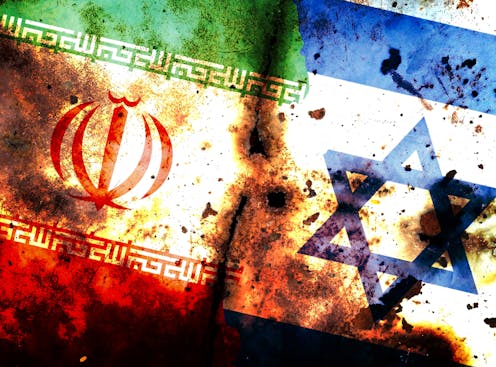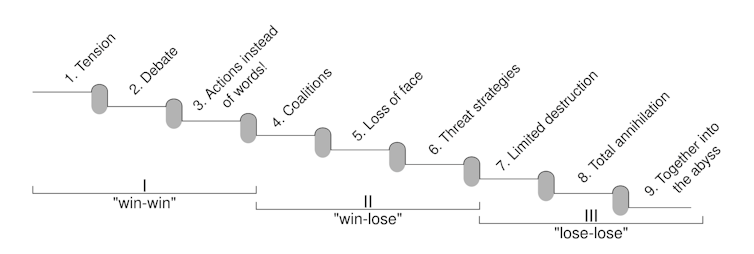
Tensions are running high in the Middle East. The murderous attack by Hamas on Israel on October 7 2023 kicked off a spiral of violence in the region. That has culminated, a year later, in Israel mounting a ground invasion of Lebanon. The invasion, which Israel says aims to confront and destroy Hezbollah, follows 12 months of tit-for-tat strikes between Israel and Iran, which have gradually escalated in intensity.
Given that Hezbollah is closely associated and supported by Iran, there is mounting concern that this conflict could become a major flashpoint in international relations. The worry is that this war might provide the spark that causes the next global conflict.
To understand how dangerous the situation could be, it’s worth looking at the theory of conflict escalation. In 1997, Austrian economist Friedrich Glasl published his nine-stage model of conflict escalation, which is generally accepted as the most sophisticated study of how conflicts can develop from disputes to all-out conflict (a step he gives the rather ominous name of “Together into the abyss”).

The first level is when a conflict is readily or easily resolved, but when a resolution is not achieved, positions on either side of the argument harden and frustration begin to mount. The next step naturally occurs when conflict parties seek to make their case, hoping to gain advantage in the court of global opinion.
Stage three of the model sees the adversaries beginning to take action. Neither side wants to yield advantage to the other, while any sense that discussion might mitigate the conflict has disappeared in mutual antagonism and mistrust. Accordingly at stage four, the conflict parties resort to an “us v them” rhetoric in an attempt to build coalitions and attract support. Stage five, described as “loss of face”, is when one or other of the antagonists feels they have become tarnished in the eyes of the community as a whole. Reputation no longer matters as much as achieving their ends. Sometimes one side or the other commits an act that it feels has isolated it, which only serves to harden it position.
In stage six, threats or ultimatums are issued. This can lead to hostilities spiralling as the conflict parties seek credibility by putting a timescale on a threat, which in turn will heighten the pressure on both sides. This can also bind another of the warring parties to a course of action from where there is little opportunity to retreat. This facilitates the move to stage seven, where the antagonists begin to trade the first limited blows in response to the threats they have made.
The world is watching the US election campaign unfolding. Sign up to join us at a special Conversation event on October 17. Expert panellists will discuss with the audience the upcoming election and its possible fallout.
In stage eight, the offensive blows intensify, with the focus on trying to injure – or even destroy – the adversary’s capacity for response or call into question the legitimacy of the other side’s leader. Often this can lead to one or another of the parties fragmenting into warring factions, making the situation increasingly uncontrollable.
As the conflict hurtles into stage nine, the threat to one or another of the parties has become existential, who are now falling “together into the abyss”. All sense of caution is abandoned as the only goal is the total annihilation of the adversary. A state of total war.
What stage are we at?
After years of animosity and denunciation on both sides, the conflict between Israel and Iran has now progressed to the stage that both sides have exchanged limited blows against each other. Reports have linked Iran to the planning of the Hamas attack on October 7. Tehran has recently denied having any part in the massacre. Hezbollah, which is more closely linked to the Islamic Republic, has carried out a year-long barrage of rockets from Lebanon into northern Israel. In response, Israel has now directly struck against Iran’s proxy, invading southern Lebanon to engage and attempt to destroy Hezbollah.
Both sides clearly want to demonstrate their power and influence in the region. But the stakes could rise if Iran feels an urgent need to protect its proxies. For Israel, its leaders have long argued that its very existence is at stake.
In terms of Glasl’s stages of escalation, the two countries appear to have reached stage seven, where they are launching limited blows against each other while avoiding direct confrontation. Both want to make their adversary consider whether the cost of continuing is worth the potential rewards that can be gained.
Iran’s air attacks on Israel suggest that while Iran can see that its regional position is being threatened and is still seeking to support the non-state actors in Gaza and Lebanon, the way in which they have conducted their attacks suggest that Tehran does not feel itself powerful enough to escalate further than it already has.
The only direct blows the two powers have launched against each other have been from the air. Iran has now launched two (large) barrages of rockets against Israel, one in April this year and again at the end of September. Both bombardments were announced in advance and neither has resulted in Israeli casualties.
Israel responded in April with a targeted strike against an Iranian airbase close to one of the country’s nuclear installations. It has yet to directly respond to the latest Iranian barrage, but Netanyahu has said Israel would target Iran’s military installations “based on Israel’s national security needs”.
Analysts believe that both sides – so far at least – are using these limited strikes to signal their unwillingness to escalate. But there is a great deal at stake. Iran will feel its position as a regional power threatened by Israel’s ground campaign in Lebanon. Meanwhile Israel has repeatedly declared that it is fighting for the security of its people. Neither appears to want a wider conflict – and their allies certainly wouldn’t encourage them if they did.
So it’s clear that – up to now at least – neither Israel nor Iran wants to venture any further down the road to “the abyss” as envisaged by Glasl’s nine-stage model.
Matthew Powell does not work for, consult, own shares in or receive funding from any company or organisation that would benefit from this article, and has disclosed no relevant affiliations beyond their academic appointment.
This article was originally published on The Conversation. Read the original article.







